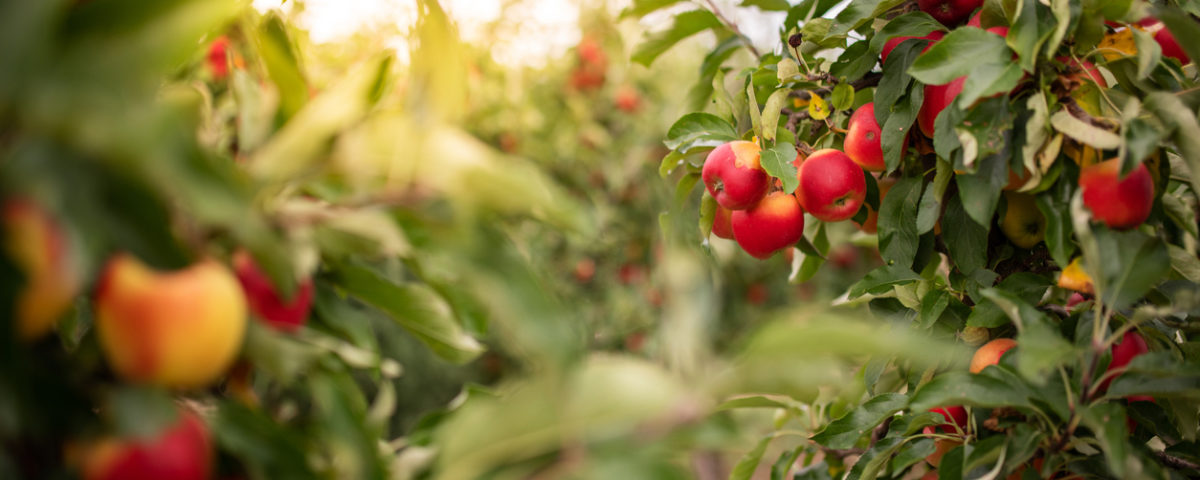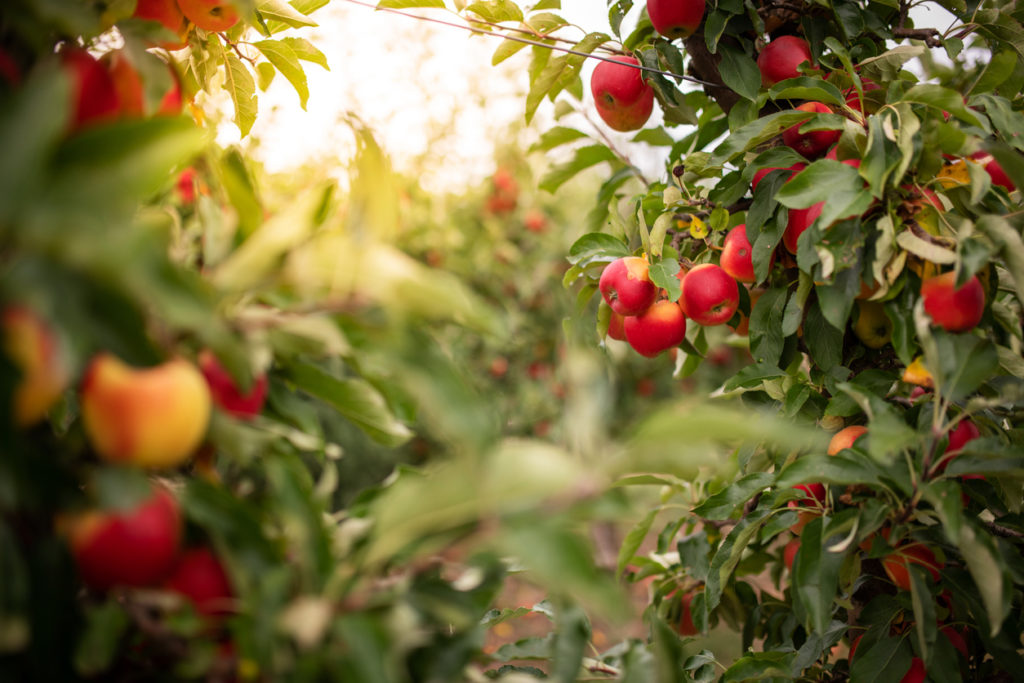- All-In-One Beekeeping for the Bees
- +1-608-728-8233
- info@beepods.com
When You Go Apple Picking This Fall, Think of the Bees

Thuringia, Germany: Ripe apples hanging on a tree in an apple orchard.

Thuringia, Germany: Ripe apples hanging on a tree in an apple orchard.
The Joys of Apple Picking
You know the feeling. The first bite of a superbly crisp and juicy Cortland apple from the local orchard. It’s fall in a single mouthful. I personally start dreaming about going to the orchard once August hits and the light starts to change. I think about eating that first apple while I’m filling my half bushel bag, baking apple crisp or cooking the apples down into homemade applesauce. Now, I also think about bees.
Since we have hundreds of orchards across the state, it’s also an easily accessible fall activity people of all ages can enjoy. However, there’s something going on behind the scenes at many of the orchards you know and love and it involves – you guessed it – bees!
Apple Orchards Use Managed Bees
Apples are one of the many crops that are dependent on pollinators for their continued success and it is common for apple orchards to rent beehives for the season to ensure they have a solid crop come fall.
You may have noticed many of the orchards near you also sell honey, though the honey is a bonus and not the primary reason for the bees; the bees are necessary to help grow the apples. In fact, at any given time a mature apple orchard should have 20-25 bees working to pollinate each tree during the growing season.
You might wonder why it’s even necessary to rent bees when you see wild bees all over your neighborhood. It’s a matter of consistency. Bees are sensitive creatures and are impacted by weather patterns, the actions of humans, and the landscape surrounding the orchard among other factors. When apple farmers have a guaranteed source of bees to pollinate their trees, it provides stability for their apples.
The French Example
It’s common practice to rent bees not just in Wisconsin, but all over the world – France included. In France, many apple farmers operate under the label, “eco-responsible,” which means they avoid pesticide use if possible, but will use interventions if it is deemed necessary to protect the apple crop. For example, apple farmers will use copper or sulfur to protect crops, but only if necessary and they apply to the apple trees at night, when the bees are sleeping in the hives.
Generally speaking, the “eco-responsible” label means finding creative solutions to preserve the health of the bees as well as their own financial livelihood as apple farmers. To avoid the use of pesticides, farmers may provide nesting sites for birds that consume insects and worms. They may also spray female pheromones to confuse male butterflies so they do not reproduce on the apple trees; butterflies produce larvae that eat the trees bare.
Actionable Steps to Help the Bees
Apple orchards can take their conservation efforts even further by keeping in mind a few major principles to help bees thrive, both rented and wild:
- Reduce or eliminate the use of pesticides
- Cultivate flowering plants
- Provide nesting sites
While rented bees provide apple orchards the stability they are looking for, wild bee populations contribute plenty to pollination and managed bees do not eliminate the need to support wild bee populations. The above points assist greatly with supporting wild bee populations.
Pesticide Use
Pesticide use is a hot topic in the news when it comes to bees. It’s best to avoid pesticide use if possible as many pesticides, even pesticide residue left on plants, can be fatal to bees. There are alternatives, such as physically removing pests from plants and placing them in soapy water. Alternatively, if orchards do require the use of pesticides, they can use less toxic varieties such as insecticidal soap, horticultural oil, and narrow-spectrum chemical insecticides.
Following the French example, it’s essential to only apply chemicals when bees are not actively foraging.
Flowering Plants
In my most recent blog post, I talked a little about what flowering plants bees like to visit in the fall. Bees are happiest when they have an abundance of plant material available to them and apple orchards can encourage the growth of plants like goldenrod, asters, lobelia, clover, sunflowers, and many varieties of herbs. This provides bees with an abundance of sources of pollen and nectar and will keep them in the vicinity of the orchard, which is good for both the bees and the apples.
It’s beneficial to plan so there are flowering plants available before apples bloom to bring bees to the area early and to have plants that flower from spring through fall.
Nesting Habitat
Supporting nesting habitat is crucial as well. While rented bees will come with a hive, it helps support wild bee populations when you provide areas for nests. Many bees nest underground, so leaving bare areas of soil can help them find places to burrow. Leaving fallen trees and plant trimmings, which often have bee larvae on them, can support populations as well.
Final Thoughts
We live in a world where so much is connected. If we want to enjoy our fall apples, apple orchards have to be able to thrive, and they are dependent on bees to produce a robust harvest. When you go apple picking this fall, I implore you to think of the bees.
Maybe that means you have a conversation with orchard staff. Maybe it means you pay closer attention to how you landscape your own yard. Perhaps it means you start raising bees yourself.
There are plenty of meaningful steps each of us can take so we can continue to enjoy apples for years to come!
Caitlin Knudsen
Latest posts by Caitlin Knudsen (see all)
- How to Change Your Students’ Lives With Project-Based Learning - November 20, 2020
- Watch The Pollinators to See How We Can All Choose to Change Agriculture - November 13, 2020
- 6 Cold Weather Feeding Tips You Have to Know - November 6, 2020



